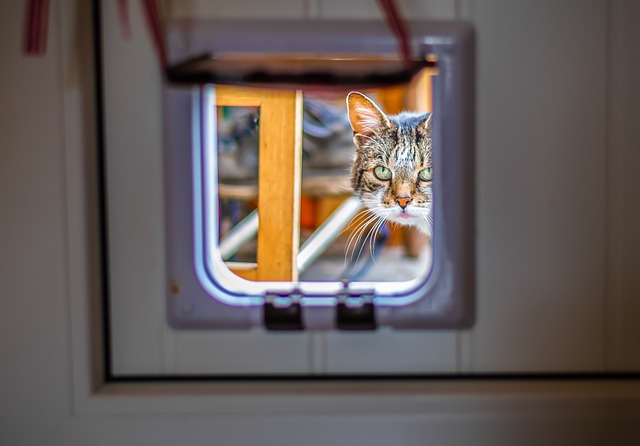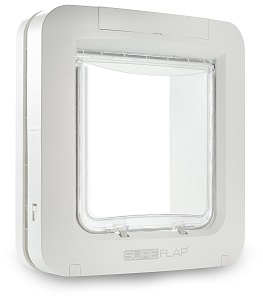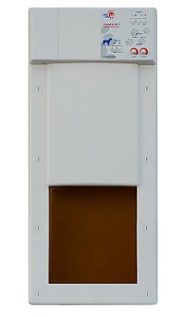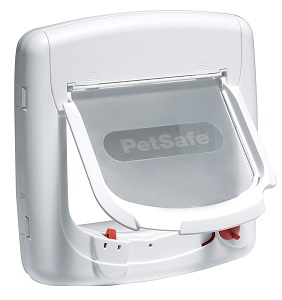
How do automatic cat doors work? Let’s start saying that an automatic cat door is a small gate in a door, wall or window with a selective locking mechanism that allows the cat to enter the house and stop any other animal from trying to access the home. Automatic or electronic cat doors require the cat to wear a key to activate the system to unlock the door, allowing the cat to push the door with its head or nose and enter the house. Automatic cat doors need to be programmed by registering the code of the cat’s tag or microchip in its memory. Depending on the technology this key could be an ID code, a color code if IR or ultrasonic signal.
Are Cat Doors a Security Risk?
When using a traditional cat flap with no locking mechanism, in rare cases some burglars may attempt to enter the house by reaching out the key somehow. It may sound obvious but never leave the house keys around the pet door. When having a cat door with a locking mechanism the door won’t open without the proper cat’s collar tag. There are more risks in installng dog doors because they are larger and a small person could fit through. When installing a pet door it’s always a good idea to also install a security camera as a deterrent mechanism.
Traditional Cat Doors vs Automatic Cat Doors
Unlike automatic cat doors, the traditional cat door simply consists in a moving “flap” that has to be pushed by the cat to get in without any locking mechanism. The concept is that any animal bigger than a cat won’t be able to access the house. However, other small animals, such as raccoons, other cats, etc. can get into the house. Today, most cat doors are electronically operated with different locking mechanisms and technologies.
Interactive Automatic vs Fully Automatic Cat Doors
Interactive Automatic: It’s the “flap” type that works with hinges and it swings to open. Once the locking mechanism registers the cat key and unlocks, the pet needs to push this door with its head or nose to get inside the house. So the interactive automatic cat door requires the feline to participate by using its body to complete the entry.
Fully Automatic: It’s the motorized cat door that looks similar to a human door in its shape. This type of cat door opens by sliding up vertically, powered by a motor. The pet does not need to do anything other than stand up facing the door and activate the mechanism with a collar for the door to slide upward open.
Pros and Cons of Automatic Cat Doors
PROS: One of the best benefits of automatic cat doors is that cats can get in and out as they please without the need of somebody opening the door each time. This provides cats a sense of freedom that they really appreciate and makes them happier. The cat access to the outside becomes crucial when their humans are not home. Also, pet doors allow cats to get back in the house if bad weather occurs.
CONS: The downside of cat doors is that it requires a house intervention to install, they need your cat to be trained to use it, unwanted animals could get inside the house, and somehow rain or dust can make their way into the house. To stop leaking rain or dust from going inside, pet doors can be blocked with a sliding mechanism parallel to the flap. Motorized fully automatic cat doors can be locked with a deadbolt lock. This is a solution when you plan to leave your cat home during bad weather.
Type of Locking Settings
Some cat doors can only be locked or unlocked (2-way locking), while others offer more options (4-way locking).
The 2-Way locking means you can only use the pet door:
- Unlocked (in & out), pets can get in and out as much as they want using the collar tag.
- Locked (in & out), pets can’t get through the door.
The 4-Way locking means you can use the door:
- Unlocked (in & out), pets are free to get in and out using the collar tag.
- Locked (in & out), pets cannot get through the door.
- Only-In, cats can’t exit the door but they can get in. This system is useful if you want your cat to stay inside the house after being out. It is also a good feature in case your pet escapes through a window or if someone let the cat out unintentionally.
- Only-Out. This mechanism allows pet only to exit the house but they can’t get back in. This feature is good if you want your pet to be outside for any reason.
Types of Automatic Cat Doors
According to the mechanism used automatic pet doors can be classified as Electronic, Motorized, and Magnetic. Automatic cat doors use different technologies for the cat’s collar to transmit a signal to the control panel to unlock it, such as infrared, electromagnetic, magnetic, ultrasonic signal and radio frequency.
1. Electronic Cat Doors
They use a tag or “key” in the cat’s collar or microchip implant which activates a latch to open the flap for the pet to push and enter. All electronic cat doors need the cat intervention to get through by pushing the door with the nose or head. Control panels are all powered by batteries, AC adapter or both. Electronic cat doors can feature 2-lock or 4-lock systems.

Types of Technologies Used to Unlock Electronic Cat Doors:
- Infrared signal. The cat wears a battery-powered collar.
- Magnetic field “electromagnetic”. The cat wears a collar with a magnet.
- High pitched sound (ultrasonic). The cat wears a battery-powered collar.
- RFID (radio frequency Identification): The cat wears a collar tag or have a microchip implanted. A microchip implant is the most modern concept of “key” to unlock the door. The microchip cat door gets activated by a microchip inserted into the pet’s skin with a unique ID code which is read and recognized by the control panel. Some RFID (radio frequency Identification) electronic cat doors feature a timer, allowing to set an “outdoor schedule” for the cat.
Watch the SureFlap in Action
The following video shows an electronic cat door that works with RFID technology to unlock the latch. This is the SureFlap Microchip cat door in action. The cat has been micro-chipped with an implant and that’s why you won’t see a collar tag.
Pros and Cons of Electronic Cat Doors
PROS
- Electronic cat doors are more effective than other systems to stop unwanted animals from following the allowed cat. The system allows you to block the access of any animal, except your cat.
- Good electronic cat doors with a 4-lock system are really effective to control your cat movements and set outdoor schedules for your feline.
CONS
- Cats need to push the door to enter and if they take too long the mechanism could lock before the door swings shut. Basically, the mechanism locks with the flap open so this will leave the door unblocked.
- A possibility of the cat getting trapped in the door. If this happens most likely the pet won’t use the door again.
- Unwanted animals could pull the flap open with their claws since some electronic pet doors do not prevent “flaps” from swinging outward, they are only blocked from being pushed.
2. Motorized Cat Doors (Fully Automatic)

The cat does not need to push the door to enter the house. A collar tag is sensed and a motor opens a vertical sliding door for the cat to get in. The range of distance to activate the motor can be adjusted. Once the cat is inside, the door slides down, shutting and locking automatically. The technology used as a “key” can be ultrasonic, magnetic or RFID. The cat door’s control panel needs to be powered.
Pros and Cons of Motorized Cat Doors
PROS
- Cats don’t need to push the door which is good, especially when cats use the paws to push the door instead of their nose or head, having problems when they want to get in because the door got locked before they tried.
- Motorized pet doors are good for timid, disable or very old cats. Also, they are good for multi-pet households with dogs and cats.
- They have a safety mechanism that keep your pet safe in case of the pet blocking the door while operating.
CONS
- While the door is opening for the cat to enter, an unwanted animal can follow behind and enter the door.
- To stop an unwanted animal to follow the cat the settings can be adjusted, shortening the time for the door to slide shut, however, the door still doesn’t have an active deterrent such as a hard swinging flap.
How Motorized Pet Doors Work
In the following video you will see a lazy dog that just wants to chill right under the motorized pet door (lol). You will see how the mechanism works, the pet doesn’t need to push the door, it opens automatically. Also, you can see the safety mechanism that makes the door to retract when sensing an blockage.
3. Magnetic Cat Doors
They use magnets to pull a lever to unlock the door when in contact with the magnet in the cat’s collar.

Pros and Cons of Magnetic Cat Doors
PROS
- This system does not need to be powered neither in the cat’s collar nor the control panel, which makes it very handy in areas where electricity is not available.
CONS’s
- Collar attracts metallic objects such as nails, and any other small metal objects to the cat’s collar.
- Other unwanted pets with a magnet can access the house.
How Magnetic Cat Door Unlocks
The following video shows a woman with a magnet in her hand and how the magnetic latch opens in contact with it.
What’s the Best Type of Pet Door for a Single Cat?
It depends on various factors but in terms of reliability and safety, the electronic microchip pet door (activating by a microchip implant) is the best option to be used by one cat. Microchip cat doors have the best control of access because when a microchip is programmed in the door’s memory, no animal with any other tag or magnet can get in the house. The other systems require a cat to wear a collar tag. Consider this fact if your feline enjoys climbing trees outside or likes to hide in narrow spaces.
What’s the Best Pet Door for Multiple-Cat Households?
There is not a “best solution” because every household is different. However, RFID (Radio-Frequency Identification) electronic cat doors are a good solution because you can register up to 40 ID’s (cats) and even more in some cases. Additionally, electronic cat doors with a 4-lock system allow cats to access from outside and inside or only outside, and only inside. This allows you to control your cats outdoor schedule much better. Motorized doors work very well for multipet households too, but these are more suitable to use for the pets to access a protected patio or yard.
Do Cats Easily Adopt Pet Doors?
Most cats adopt electronic doors easily and they learn how to use them with proper training. Timid, nervous, disable or elderly cats might get intimidated by electronic pet doors. If this is the case, you have the option of the motorized pet door that allows the cat to get in without the need of pushing the door. Consider this solution for your cat to access a fenced area. Whatever you choose for your cat, you’ll give your f eline friend freedom to enjoy the outdoors.
Are Cat Doors Different From Small Size Dog Flaps?
They are, indeed, different. Small size dog doors have a more rectangular shape, they have metal frames and the flap tends to be more flexible but there are also hard flaps. On the other hand, cat doors have a square shape, the material of the flap is usually hard polycarbonate and acts as a deterrent when bouncing against possible unwanted animals. The frame of cat doors usually is made from plastic. Of course, this is not the rule; there are a lot of different types of pet doors on the market.
As you can see, they are several types of automatic cat doors and how they work will help you to decide what you need, according to your lifestyle and your pet’s personality.
Some content contains affiliate links or samples for reviews; I may receive compensation. Learn more
I never knew that small-sized dog doors are more rectangular in shape while cat doors are more square. My husband and I are thinking of adopting a cat since our youngest child recently moved off to college, and the house has been too quiet since she’s gone. We want to make sure the cat has plenty of freedom, so we’ll have to start looking for a great cat door!
Hello Shayla, what a great idea! Cats are wonderful creatures and make great pets. If possible, it would be so lovely if you could adopt a cat, they really need to be rescued and are suffering so much. Thanks for your comment and good luck with your new family member :)